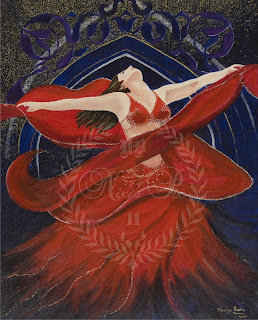Oh, how I love Portugal!
We took the bus to Sintra, a fairytale village in the Serra de Sintra (Sintra Mountains). The village, which is about 30 kilometres from Lisbon, is on the Unesco World Heritage list for its Romantic 19th century architecture.
 |
| http://realtravel.com/dp-16783-0-sintra_photos |
 |
| http://www.flickr.com/photos/brainspiration/371525504/ |
Hubby decided that this was where he would play photographer and take pictures of his young wife traipsing down the stairs. Which is fine, but it was in the pre-digital age, where you didn't just shoot away. You had to plan, and be patient.
So with knees a bit wobbly after a long day's sightseeing, I ran up the stairs and lightly floated downwards, all the while smiling prettily at the colourful surroundings and pretending that I did not feel extremely awkward.
When I reached the bottom, hubby said: "Would you mind doing it again? I didn't get a picture."
So I turned around and scampered up the steps to the top. Merrily, I ambled down again.
"Uhm ... nope. Please try again."
Without much ado, I walked up again, to the top. And dooown I came again.
Hubby smiled patiently. "Lets try one last time, please?"
I marched back up, slowly and deliberately putting my feet on every step on the way down.
Only to be greeted with one of those puppy-eyed stares.
"I promise this will be the very last time."
Up I stomped, and halfway down I demanded: "Why don't you just take the damn picture? What is wrong?"
With the tact of the Dalai Lama, he declared: "Girl, you really look hot and bothered!"
Incredibly, it is 21 years later and we are still married!
After I did the painting of the chickens in Paris, I thought that it migt be fun to do chickens in places that have special meaning for me. I remembered Sintra, and those steps ...
 |
| Galhinas pintadas (Painted chickens) |
Incidently, the chicken at the top of the stairs is my rendition of the famous Portuguese rooster, or O Galo de Barcelos ("the rooster of Barcelos").
Then one day a stranger passed through town. He was immediately suspect, and was seized by the authorities. Despite all his protestations and explanations that he was on his way to worship a saint in a nearby town, St. Tiago, he was sentenced to death by hanging.
His last request was to see the judge who had condemned him. He was taken to the house of the magistrate, who was about to enjoy his supper.
The doomed pilgrim again proclaimed his innocence, and in desperation pointed to the roasted chicken on the table and blurted out: "If I am innocent, this rooster will crow three times."
Of course everybody laughed at him, yet nobody dared to touch the dish on the table.
And so off to the gallows he went ... but just as the noose of the hangman's rope slipped over the poor pilgrim's head, the rooster stood up from the platter and crowed. The judge had no choice but to release the pilgrim.
Many years later the pilgrim returned to Barcelos and erected a monument in praise of St. Tiago and the Holy Virgin.
To this day, Galo de Barcelos, the symbol of honesty, integrity, trust and honor, still is the national symbol of Portugal.
♥










